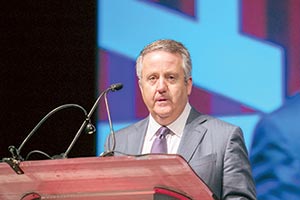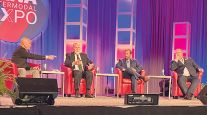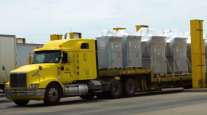Tough Times for Intermodal as Freight Slows, Execs Say

This story appears in the Sept. 26 print edition of Transport Topics.
HOUSTON — Intermodal businesses that have become accustomed to long-term growth likely are facing tougher times ahead in the form of a recession, changing freight patterns and other obstacles.
Noel Perry and Larry Gross, both officials at consultant FTR, and Wall Street analyst Brandon Oglenski sketched the challenges ahead for an intermodal industry whose volumes have shrunk for four consecutive quarters — after 23 straight growth periods that included market share gains during the latest recession.
They spoke last week at the Intermodal Expo here, joined by BNSF Railway Chairman Matt Rose, who pinpointed additional barriers to intermodal growth.
Perry, an economist and former official at Schneider and CSX, said a recession is “highly likely” as early as next year simply because the current recovery has run its course.
“It is likely to be difficult times for intermodal and trucking,” Perry said. “If we have a recession, traffic won’t come back quickly. Very likely, your volumes won’t be much higher than they are now.”
At most, Perry said, he expects 1.1% intermodal growth two or three years from now, far below the steady growth pace in the 3% to 5% range since the latest recession began, and for most years before. Amid expectations for a looming recession, fleets also will have to adjust to expected capacity reductions from regulations such as electronic logging devices next year by finding more drivers, who already are in short supply.
Rose criticized a “horrendous” 2016 state court decision, now under appeal, that blocked BNSF’s Southern California International Gateway. That project would have taken tens of millions of truck miles off a congested freeway by building a $500 million terminal closer to Los Angeles and Long Beach, California, docks, adding capacity for expected future growth at the largest rail intermodal operator.
“It threatens our ability to grow, not just for BNSF but everybody in this room,” Rose said. “How do we grow with our hands tied?”
On the regulatory front, he questioned Surface Transportation Board steps to review current rate and service policies, which he said have created an environment where railroads have been able to reinvest to improve service. Recent declines in coal shipments and revenue also pose a challenge to intermodal, he said, because revenue is needed from all freight categories to sustain reinvestment.
Oglenski, director of research at Barclays Capital Inc., didn’t forecast much improvement in the ocean freight sector that feeds intermodal due to competitors’ willingness to keep building ever-larger ships faster than freight volumes increase.
“The [liner] industry is on an unsustainable path,” he said, with the recent Hanjin Shipping Co. bankruptcy that is “more of a symptom than a solution.”
Gross, another FTR official who also previously was an industry executive, said that “intermodal has a tall task ahead” for the railroads because, even when truck-rail growth resumes, those shipments generate about 70% less revenue per shipment than other freight that has been on the decline, such as coal. Rail coal revenue has dipped about 25% year-over-year in 2016.
Gross also pinpointed two other indicators that are hurting the truck-rail sector: a shift in inland movements of international freight and a sharp drop-off in intermodal trailer shipments by truckers.
“Inland intermodal has become uncoupled from the port sector,” Gross said, compared with past years when intermodal freight moved in “lockstep” with import statistics. This year, imports have risen 1.6%, but inland moves of international cargo via intermodal are off 4.5%.
On the domestic front, the 29% decline in intermodal trailer shipments is a “canary in the coal mine” because truckers who own that equipment can choose to run over the road instead of truck-rail service.
Truckers could be taking advantage of lower fuel costs, he said. Shippers also could be transloading more international freight into domestic trailers and containers before it moves out of port regions, he said.
Even after Hanjin’s Aug. 31 bankruptcy that reduced capacity, Oglenski believes the vessels already built and on order will keep adding capacity at a 4% to 5% rate for the next four or five years. Part of the issue, he said, is that carriers owned by sovereign nations, such as China, rather than the private sector view transport as an extension of their export policy, which doesn’t have to be profitable.
There were a few bright spots.
Gross believes U.S. domestic intermodal will be resilient enough to move 2.4% more freight next year despite those trends, compared with the 3% decline year-to-date versus 2015.
Oglenski believes long-term conversion of highway freight to intermodal is likely.
Rose hailed the long-term growth of intermodal that grew twice as fast as GDP from 1991 until the current slowdown, saying it was “so phenomenal you had to be part of it to believe it.”




